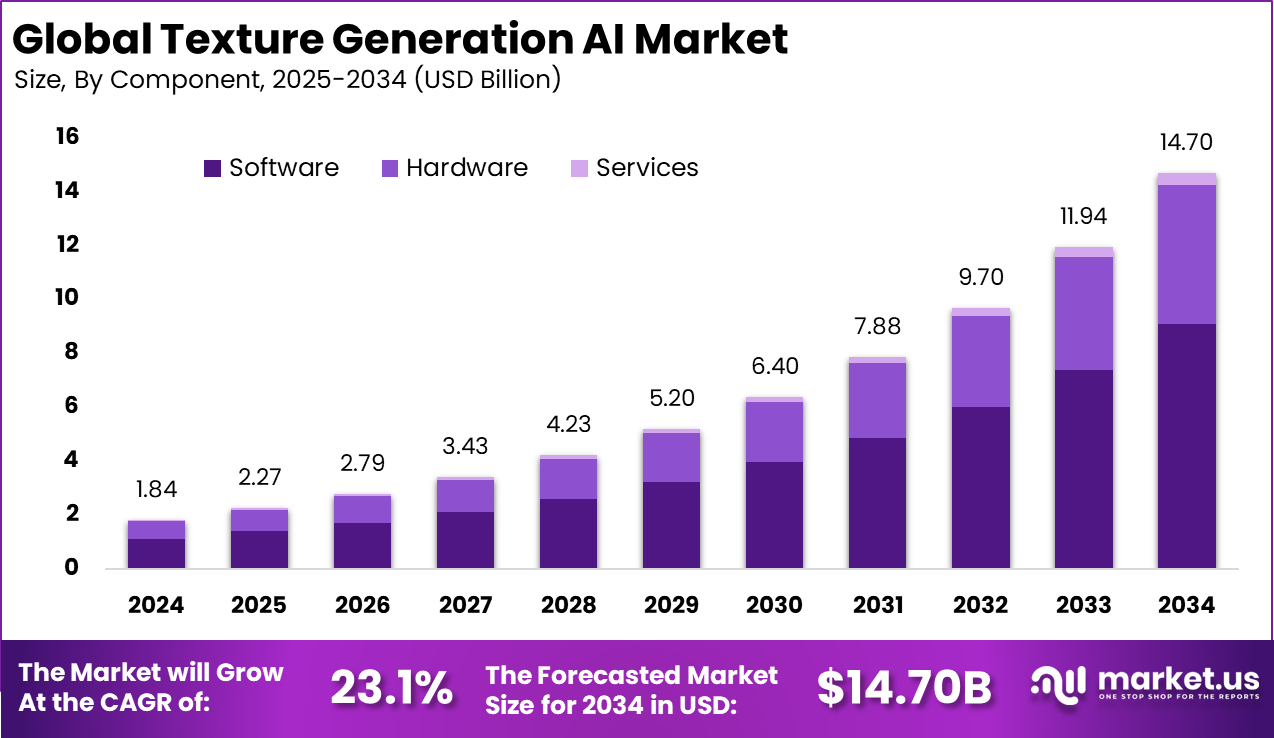Table of Contents
Introduction
The Global Texture Generation AI Market, valued at USD 1.84 billion in 2024, is accelerating rapidly as industries adopt AI-driven tools for real-time, high-fidelity, and scalable texture creation. With a strong 23.1% CAGR, the market is projected to reach USD 14.70 billion by 2034. Growth is fueled by gaming, visual effects, metaverse development, product design, and architecture. North America leads the landscape with a 42.5% share (USD 0.78 billion), supported by strong digital content creation and AI innovation ecosystems.

How Growth Is Impacting the Economy
The surge in Texture Generation AI is reshaping content-driven economies by reducing production costs, accelerating creative workflows, and enabling large-scale digital asset manufacturing. This rapid adoption lowers dependency on manual texture artists, allowing creative teams to deliver assets faster and at significantly reduced overhead.
As industries expand into immersive technologies—gaming, VR/AR, simulations, digital twins—the economic value generated through AI-driven texture automation rises substantially. The expected jump to USD 14.70 billion by 2034 also stimulates investment in cloud computing, GPU infrastructure, and digital-design platforms. Additionally, faster prototyping cycles and reduced design labor costs positively influence manufacturing, entertainment, education, and e-commerce sectors, strengthening macroeconomic digital transformation.
➤ Smarter strategy starts here! Get the sample – https://market.us/report/texture-generation-ai-market/free-sample/
Impact on Global Businesses
Rising GPU costs, cloud-compute expenses, and data-processing requirements push companies toward hybrid and edge AI deployments. Supply chains are shifting to digital pipelines where automated asset generation replaces outsourced manual workflows. Industry-specific impacts include gaming acceleration, metaverse content scalability, real-time visualization in architecture, automated texture catalogs for product companies, and faster digital prototyping in automotive and consumer electronics.
Strategies for Businesses
Businesses should adopt cloud-native AI texture platforms, invest in high-performance GPUs, and integrate generative pipelines directly into design engines. Prioritizing data governance, custom model training, and large-scale asset libraries will enhance output quality. Strategic collaborations with AI design startups, continuous staff upskilling, and leveraging multimodal generation engines can improve creative productivity and reduce operational load.
Key Takeaways
- Market projected to reach USD 14.70 billion by 2034.
- Robust 23.1% CAGR from 2025–2034.
- North America leads with 42.5% market share.
- Fast adoption across gaming, VFX, digital twins, and metaverse ecosystems.
- AI-driven automation cuts production time and boosts creative output.
➤ Unlock growth secrets! Buy the full report – https://market.us/purchase-report/?report_id=166924
Analyst Viewpoint
Present adoption trends show powerful momentum as generative AI transitions from experimental use to core production workflows. Texture Generation AI is becoming indispensable in gaming, VR, manufacturing visualization, and cinematic design. The future outlook remains highly positive as multimodal AI, diffusion models, and real-time rendering engines improve texture accuracy. Emerging markets, affordable GPUs, and low-latency cloud systems are expected to accelerate global adoption. As enterprises shift to AI-first production pipelines, the market’s value proposition strengthens significantly.
Use Cases & Growth Factors
| Use Case | Description | Growth Factors |
|---|---|---|
| Gaming & VFX | Realistic textures for characters, worlds & assets | Rising demand for immersive gameplay and films |
| Architecture & Digital Twins | AI-generated materials for simulations | Expansion of VR/AR and real-time visualization |
| Product & Industrial Design | Rapid texture prototyping | Faster product cycles & cost efficiencies |
| Metaverse & Virtual Commerce | Large-scale asset generation | Increased adoption of virtual environments |
Regional Analysis
North America dominates the market with 42.5% share due to its strong gaming, film, and tech ecosystem combined with high AI R&D spending. Europe follows, driven by advancements in automotive visualization, architectural design, and government-backed AI initiatives. Asia-Pacific is the fastest-growing region supported by booming gaming markets in China, Japan, and South Korea. Emerging regions in Latin America and the Middle East are gradually adopting AI texture tools as digital content industries expand.
➤ Want more market wisdom? Browse reports –
- Player Performance AI Market
- AI Commentary Service Market
- AI Patent Search Market
- ESG-Linked Insurance Market
Business Opportunities
Key opportunities include real-time generative pipelines, industry-specific texture libraries, AI-assisted 3D material scanning, and integration of generative texture tools into game engines. Additional opportunities arise in e-commerce visualization, autonomous vehicle simulation, training datasets for robotics, and virtual fashion environments. Startups can capitalize on specialized micro-texture models, cloud-rendering optimizations, and enterprise-grade creative automation platforms.
Key Segmentation
The market is segmented by technology (diffusion models, GANs, neural rendering), application (gaming, VFX, architecture, product design, simulations), deployment (cloud-based, on-premises), and end-user (game studios, film production houses, enterprises, automotive designers, metaverse developers). Each segment demonstrates strong demand as industries shift to AI-enhanced creative workflows. Future growth will favor real-time rendering and multimodal generative systems.
Key Player Analysis
Leading participants focus on advancing neural texture synthesis, improving resolution fidelity, and reducing rendering latency. Their strategies emphasize integrating generative AI into production engines, enhancing customization, and building scalable cloud workflows. Competitors invest in high-quality dataset curation, GPU-accelerated modeling, and APIs for seamless integration across design pipelines. Efforts also target domain-specific models, procedural generation enhancements, and global expansion through strategic partnerships.
- Google DeepMind
- Meta Platforms, Inc.
- IBM Corporation
- Microsoft Corporation
- Unity Technologies
- Autodesk, Inc.
- Stability AI
- Runway ML
- Promethean AI
- Lightricks
- Adobe Inc.
- NVIDIA Corporation
- OpenAI
- DeepArt.io
- Obvious
- Prisma Labs
- Playform IO
- Wombo AI
- Others
Recent Developments
- Introduction of diffusion-based texture engines for ultra-realistic material generation.
- Launch of cloud platforms offering scalable generative texture rendering.
- Integration of AI texture APIs into leading game development environments.
- Expansion of real-time neural rendering tools for immersive applications.
- Collaborations to build large proprietary texture datasets for enterprise use.
Conclusion
The Texture Generation AI Market is experiencing rapid global adoption, reshaping digital content creation across industries. With strong growth projections and expanding use cases, AI-driven texture automation is positioned to become a core driver of next-generation design, gaming, and visualization ecosystems worldwide.
Discuss your needs with our analyst
Please share your requirements with more details so our analyst can check if they can solve your problem(s)



